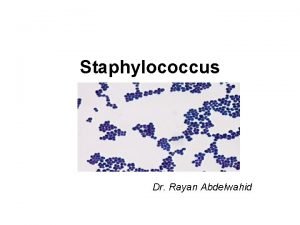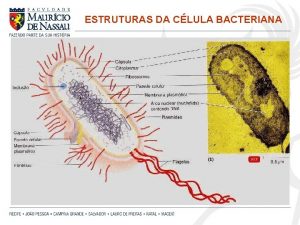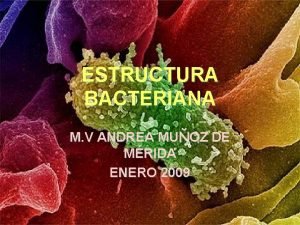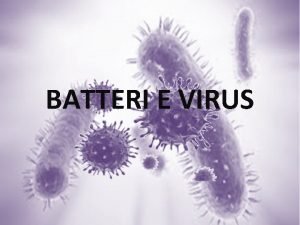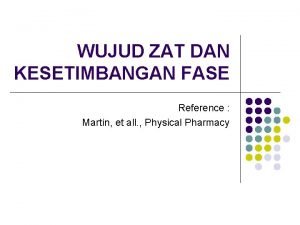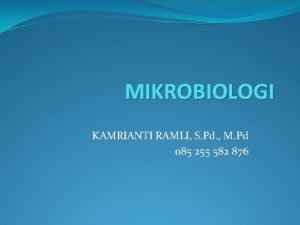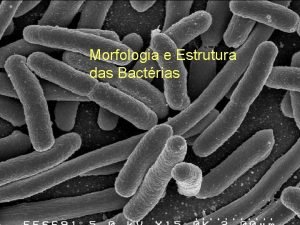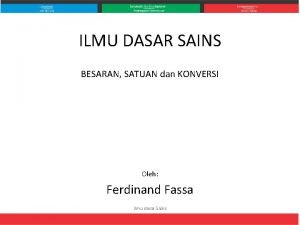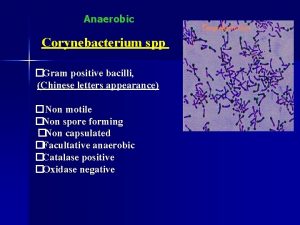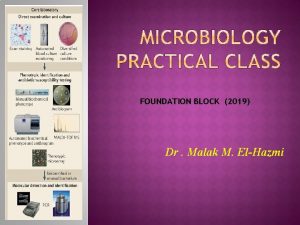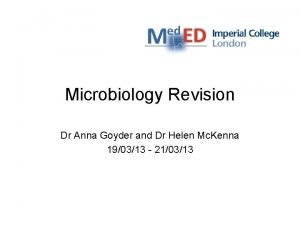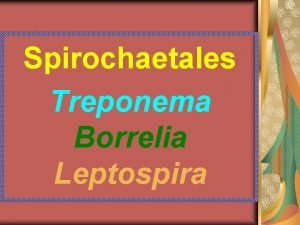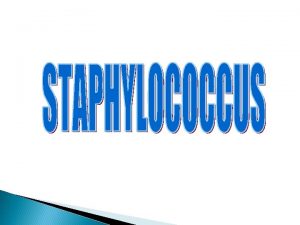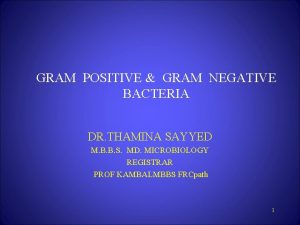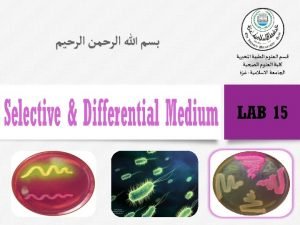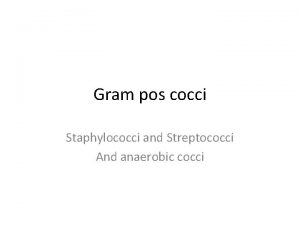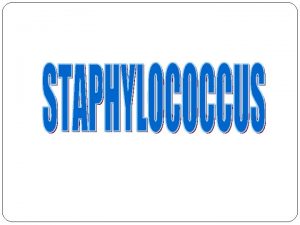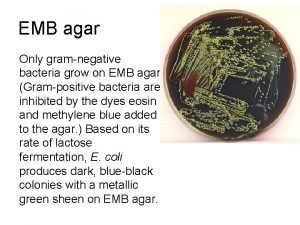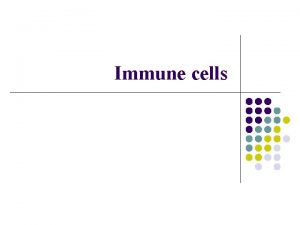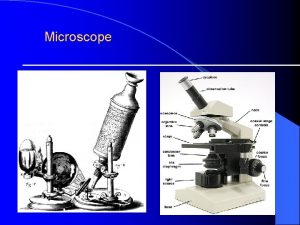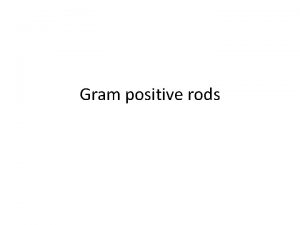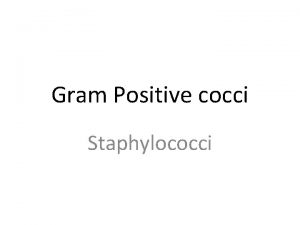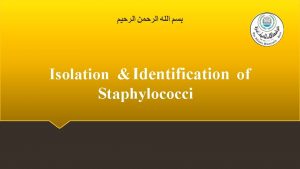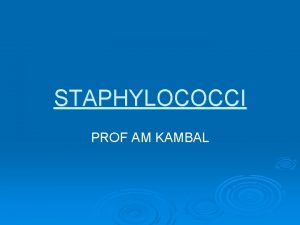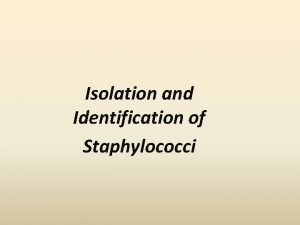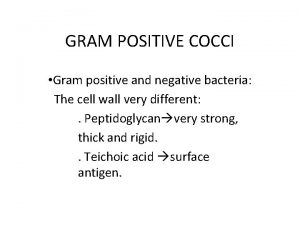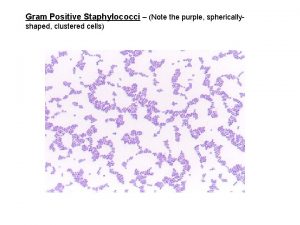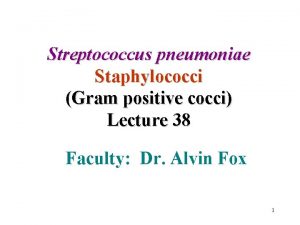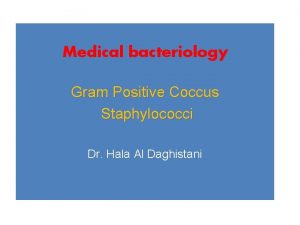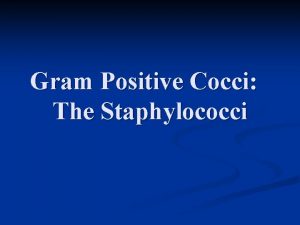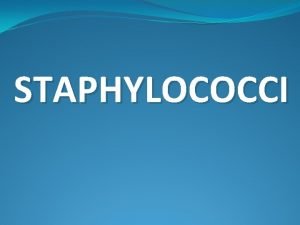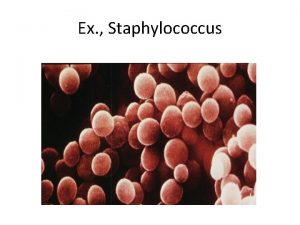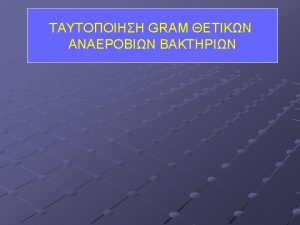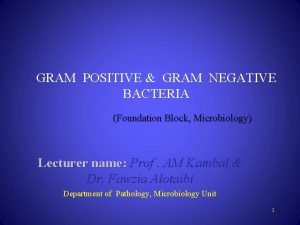Part 1 Dr Salma Staphylococci are Gram positive





































- Slides: 37

Part 1 Dr. Salma


Staphylococci are : -Gram positive cocci, -Occur in grape like clusters, -They are non motile and non sporing. -A few strains possess capsules -Produce pigments

Cultural Characteristics: i) On nutrient agar- The colonies are large, circular, convex, smooth, shiny, opaque. Most strains produce golden yellow pigments.

ii) On Mac. Conkey’s agar- The colonies are small & pink in colour. iii) On blood agar- Most strains produce βhaemolytic colonies.

CLASSIFICATION: A) Based on coagulase production: 1. Coagulase positive: Eg- S. aureus 2. Coagulase negative: Eg- S. epidermidis S. saprophyticus B) Based on pathogenicity: 1. Common pathogen: Eg- S. aureus 2. Opportunistic pathogens: Eg- S. epidermidis , S. saprophyticus 3. Non pathogen: Eg- S. homonis

S. aureus S. epidermidis Skin infections Prosthetic Infection Osteomyelitis Food poisoning Toxic shock syndrome Pneumonia Acute endocarditis Infective arthritis Necrotizing fasciitis Sepsis UTI especially in patient with catheter & low immunity. S. saprophyticus UTI in sexually active females Non Gonococcal Urethritis in males.

CULTURE: Media used : i) Non selective media: Nutrient agar, Blood agar, Mac. Conkey’s agar. ii) Selective media: Salt-milk agar,

s. aureus s. epidermidis

MANNITOL SALT AGAR Na. Cl 7. 5% selective Mannitol differential Staphylococcus aureus can ferment mannitol, so the selective media used to isolate Staphylococcus aureus especially from nasal carriage is (Mannitol Salt Agar)

Biochemical tests: Coagulase test: DETECT the ability of S. aureus to clot blood plasma (fibrinogen fibrin). Slide method Tube method Catalase test: To differentiate between Staph. & Strepto.

Biochemical reactions: 1) Catalase test- Positive.

2) Coagulase testi) Slide coagulase test- Positive. ii) Tube coagulase test- Positive. SLIDE COAGULASE TEST TUBE COAGULASE TEST

3) Reduces nitrate to nitrite. 4) Ferments mannitol anaerobically with acid only. 5) Urea hydrolysis test- Positive. 6) Gelatin liquefaction test- Positive. 7) Produces Lipase. 8) Produces Phosphatase. 9) Produces nuclease.

PATHOGENICITY: Source of infection: A) Exogenous: patients or carriers B) Endogenous: From colonized site Mode of transmission: A) Contact: direct or indirect( through fomites) B) Inhalation of air borne droplets

Virulence factors: These include A) Cell associated factors B) Extracellular factors

A) CELL ASSOCIATED FACTORS: a) Cell associated polymers b) Cell surface proteins a) CELL ASSOCIATED POLYMERS 1. Cell wall polysaccharide 2. Teichoic acid 3. Capsular polysaccharide b) CELL SURFACE PROTEINS: 1. Protein A 2. Clumping factor (bound coagulase)

Structure of Staphylococcal cell wall

Virulence factors of Staphylococcus aureus III.

B) EXTRACELLULAR FACTORS a) Enzymes b) Toxins

a) Enzymes: 1. Free coagulase 2. Catalase 3. Lipase 4. Hyaluronidase 5. DNAase 6. Thermonuclease 7. Staphylokinase (Fibrinolysin) 8. Phosphatase

b) Toxins: 1. Cytolytic toxins i) Haemolysins Alpha haemolysin Beta haemolysin Gamma haemolysin Delta haemolysin ii) Leucocidin (Panton-Valentine toxin) 2. Enterotoxin 3. Toxic shock syndrome toxin (TSST) 4. Exfoliative (epidermolytic toxin).

Disease: Diseases produced by Staphylococcus aureus is studied under 2 groups: A) Infections B) Intoxications

A) INFECTIONS: Mechanism of pathogenesis: Cocci gain access to damaged skin, mucosal or tissue site Colonize by adhering to cells or extracellular matrix Evade the host defense mechanisms and multiply Cause tissue damage

Common Staphylococcal infections are: 1) Skin and soft tissue: Folliculitis, furuncle (boil), carbuncle, styes, abscess, wound infections, impetigo, and less often cellulitis. Folliculitis

Furuncle (boil) Carbuncle

Styes Abscess

Impetigo Wound infection Paronychia Cellulitis

2) Musculoskeletal: Osteomyelitis, arthritis. 3) Respiratory: Tonsillitis, pharyngitis, sinusitis, otitis, bronchopneumonia, lung abscess, rarely pneumonia.

4) Central nervous system: Abscess, meningitis, . 5) Endovascular: Bacteremia, septicemia, pyemia, endocarditis, Urinary tract infection.

B) INTOXICATIOINS: The disease is caused by the bacterial exotoxins, which are produced either in the infected host or preformed in vitro. There are 3 types. Food poisoning Toxic shock syndrome Staphylococcal scalded skin syndrome

1) Food poisoning: Enterotoxin is responsible for manifestations of staphylococcal food poisoning. Eight types of enterotoxin are currently known, named A, B, C 1 -3, D, E, and H. It usually occurs when preformed toxin is ingested with contaminated food. The toxin acts directly on the autonomic nervous system to cause the illness, rather than gut mucosa.

The common food items responsible are - milk and milk products, meat, fish and ice cream. Source of infection- food handler who is a carrier. Incubation period- 2 to 6 hours. Clinical symptoms- nausea, vomiting and diarrhoea. The illness is usually self limited, with recovery in a day or so.

2) Staphylococcal Toxic shock syndrome (STSS): STSS is associated with infection of mucosal or sequestered sites by TSST( formerly known as enterotoxin type F) producing S. aureus. It is fatal multisystem disease presenting with fever, hypotension, myalgia, vomiting, diarrhoea, mucosal hyperemia and erythematous rash which desquamates subsequently.


3) Staphylococcal scalded skin syndrome (SSSS): Exfoliative toxin produced by S. aureus is responsible for this. It is a skin disease in which outer layer of epidermis gets separated from the underlying tissues.

THANK YOU
 S. agalactiae catalase test
S. agalactiae catalase test Antigentest åre
Antigentest åre Coagulase negative staphylococcus
Coagulase negative staphylococcus Lofotríquio
Lofotríquio Flagelo
Flagelo Eubatteri
Eubatteri Tekanan uap larutan
Tekanan uap larutan Fase formula
Fase formula Bakteri gram positif dan negatif
Bakteri gram positif dan negatif Parede celular
Parede celular Mole-mole stoichiometry
Mole-mole stoichiometry Buktikan rumus rumus berikut benar secara dimensi
Buktikan rumus rumus berikut benar secara dimensi Diagram 3 fase
Diagram 3 fase Salma berrada souni
Salma berrada souni Yeni salma barlinti
Yeni salma barlinti Gcg menurut para ahli
Gcg menurut para ahli Yeni salma barlinti
Yeni salma barlinti Yeni salma barlinti
Yeni salma barlinti Pretty salma
Pretty salma Salma acronym georgia
Salma acronym georgia Santa veronica giuliani corpo incorrotto
Santa veronica giuliani corpo incorrotto Contoh soal dan pembahasan teori kinetik gas
Contoh soal dan pembahasan teori kinetik gas Gram negative and positive bacteria
Gram negative and positive bacteria Gram positive bacilli chinese letters
Gram positive bacilli chinese letters Streptococcus pneumoniae csf
Streptococcus pneumoniae csf Gram
Gram Helen mc
Helen mc Spirochete gram positive or negative
Spirochete gram positive or negative Gram positive cocci
Gram positive cocci Gram positive bacili
Gram positive bacili V
V Erythrogenic toxin
Erythrogenic toxin Curb-65
Curb-65 Gram positive cocci
Gram positive cocci Gram positive cell wall
Gram positive cell wall Staphylococcus epidermidis on emb agar
Staphylococcus epidermidis on emb agar Gram positive bacteria
Gram positive bacteria Difference selective and differential media
Difference selective and differential media


